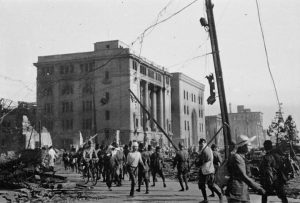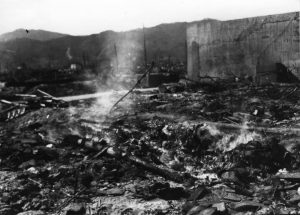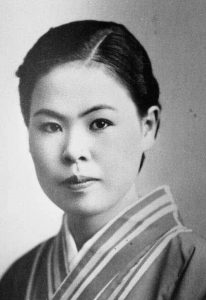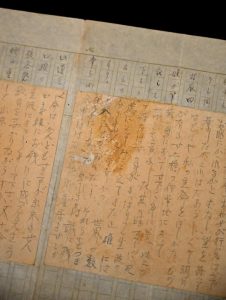Documenting Hiroshima of 1945: August 8, smoke from cremations at relief station
Aug. 8, 2024
“It was like watching scene from hell”
by Kyosuke Mizukawa, Senior Staff Writer
On August 8, 1945, two days after the atomic bombing, smoke from the cremation of bodies rose into the air near the building of Honkawa National School (present-day Honkawa Elementary School, in Hiroshima’s Naka Ward), which withstood the fires in the central area of Hiroshima. Toshio Kawamoto, a member of the Hiroshima Prefectural Police Department’s photography team who died in 1968 at the age of 66, took a photograph of the cremation site as he moved around taking photos of the situation in the city.
The reinforced-concrete school building, which had evaded collapse 410 meters from the hypocenter, was turned into a relief station. Hideo Kimura, 89, a resident of Hiroshima’s Asaminami Ward, was 10 years old at the time and had evacuated to the school building’s basement with his family. Recalling his experience from that time, Mr. Kimura said, “It was like watching a scene from hell… .” He added, “Every day, several people died at the relief station, and to cremate the bodies, soldiers would collect them in the open space in front of the school.”
Boy was asked to “keep watch on fire”
At the time, Mr. Kimura was a fourth-year student at Misasa National School (present-day Misasa Elementary School, in Hiroshima’s Nishi Ward), and experienced the atomic bombing near the school’s provisional building, located about 1.4 kilometers from the hypocenter. His home, in the area of Nakahiro-cho (in the city’s present-day Nishi Ward), had collapsed and fires had spread to his neighborhood. With his mother and sisters, he fled to a bamboo grove in the area of Mitaki-machi (in present-day Nishi Ward). Several days later they moved to Honkawa National School.
In the relief station set up in the basement of the school, the wounded, lying side by side, audibly groaned. The burns of some of the wounded were filled with pus and infested with maggots. Because Mr. Kimura had only suffered relatively minor injuries, he was asked by the soldiers to keep a watch on the cremation fire. “I would collect unburnt timbers from the scorched ruins and make sure the fire wouldn’t die down day and night.”
Michiko, the first daughter of Mr. Kimura’s older sister, Hatsuko, was one of those who died at the relief station. Mr. Kimura said, “I cannot forget my sister crying through the night after her daughter’s death.” Michiko was only around one year old.
Smoke from the cremation fires spread into Hiroshima’s suburbs. The body of Fujie Yoneda, a first-year student at Hiroshima Prefectural First Girls’ High School (Prefectural Girl’s School; present-day Minami High School) at the time, was cremated near her home in the area of Gion-cho (in Hiroshima’s present-day Asaminami Ward) on August 8.
In a journal entry of hers dated August 5, 1945, she wrote “I plan to work hard.” Then, on August 6, she went to the Dobashi area (in Hiroshima’s present-day Naka Ward), around 800 meters from the hypocenter, to help with the work of building demolition for the creation of fire lanes as a mobilized student. On the morning of August 7, her mother, Chie Yoneda (who died in 1983 at the age of 79), found her daughter in tattered clothes at a relief station located in Koi National School (present-day Koi Elementary School, in the city’s Nishi Ward), where she and her husband visited in search of their daughter. Fujie had died there a mere three hours before their arrival.
“I was told she had died shouting, ‘Mother, water… .’ I held onto her dead body and burst into tears,” wrote Chie in her personal account. The parents made a make-shift stretcher from a wooden shutter, on which they placed their dead daughter to take her home.
Worried about deaths of students after bombing
The Prefectural Girls’ School lost a total of 301 people in the bombing, including students, teachers, and school staff. Sachiko Mitsutani, 29 at the time, was an escorting teacher of first-year students at the school. Ms. Mitsutani asked a female student at a relief station in Kannon National School (present-day Itsukaichi Kannon Elementary School, in Hiroshima’s Saeki Ward) to write a farewell note in her place on the evening of August 7, in anticipation of her own death. Ms. Mitsutani’s note remains today. She remained concerned until the end about how many students had died.
“At the work site in Dobashi, more than half of my body was already burned due to the initial bomb explosion,” the note reads. “Countless students have crossed to the other side. I feel truly sorry and regretful that I will die without identifying how many have died.” Ms. Mitsutani died on August 8 and was cremated.
(Originally published on August 8, 2024)











